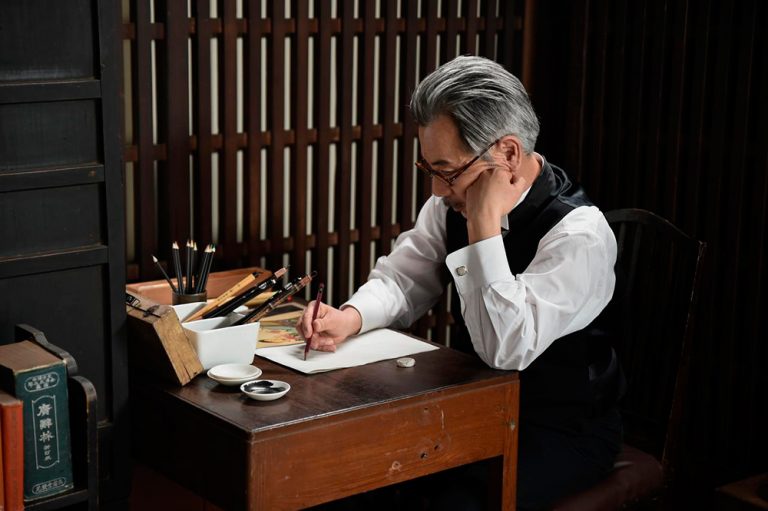
The Manga Master is a 2019 biopic about the life of Rakuten Kitazawa, the pioneer of modern manga in Japan. The film was screened at the British Museum and is currently part of the line-up of the Chicago Japan Film Collective.
Today, manga is part of global cultural, as an example of how Eastern influence has permeated in the West. The Japanese word that originally means ‘whimsical drawings’ is associated with the depictions in comic books that represent pieces of Nipponic culture and history. These distinct Japanese drawings can be found in scrolls dating back to the 12th century, but it is with the collection of sketches known as Hokusai Manga, made by artist Katsushika Hokusai, that the genre started to shape itself. And this is what inspired Rakuten Kitazawa to develop this art into a unique creative discipline that would possess the power of satire through a new form of storytelling.
The Manga Master is the re-enactment of the artist’s life, starting with the elderly Kitazawa in 1943, played by the great actor Issey Ogata. The fiction takes artistic license to create a rivalry between him and Okamoto, to discuss the creative dilemma of artists and how they place themselves in relation to the art of drawing. Throughout his life Kitazawa’s devoted wife Ino (played by TV personality and artist Tomoe Shinohara) is always by his side, supporting him and appraising his work.
Director Moe Oki, dedicates her second feature to this important figure in Japanese culture. She tributes his intellectual ardour, curiosity and courage, and she also explores the existential meaning of being an artist. In terms of her cinematic style, Oki seems to alternate shots that evoke Ozu’s “tatami shot” in which the camera is placed at a low height — particularly in the flashback scenes that portray the young Rakuten in tea houses or at home with his wife — with a more modern and dynamic approach that is enhanced by the vivid colours of the cinematography by Kenji Akama. The story extensively covers the way Kitazawa started experimenting with his sketches and evolved to the role of ‘Sensei,’ who later inspired the likes of Osamu Tezuka and Machiko Hasegawa. Editor Yoshinori Ota, skilfully blends in the cut also archival footage of mangas.
The Manga Master craftily unveils the theme of the political power of art. Rakuten grew up in a particular historical moment in his country, a few years after the Meiji restoration, in the midst of social and cultural upheavals, that contributed to shaping his personality and critical spirit towards Japanese society and politics. During this era, Japan was shifting from being an isolated feudal society to becoming an industrial and emergent great power, that had to welcome some Western influence in order not to become its colony.
Within this setting, the passion for drawing of the young Rakuten is enhanced as he discovers American comics. Among the periodicals he reads with interest Box of Curios, a weekly published in Yokohama. He eventually joins this English-language magazine as an illustrator, and shortly after his drawings gain the attention of Yukichi Fukuzawa, one of the leading intellectuals of the period and founder of the newspaper Jiji Shimpō. Hence, the young Rakuten joins the drawing staff of the Sunday supplement Jiji Manga, on whose pages he presents himself as a journalist and mangaka, thanks to a space dedicated to current affairs that immediately becomes very popular.
Kitazawa’s artistry is innovative, because he draws political comics in a western style, although they aren’t always necessarily aimed at affairs of state. In fact, Kitazawa develops some recurring characters, and filmmaker Oki, creates a beautiful animation homage, making Rakuten’s creations leave the page into a short but exquisite moment of Japanimation.
The film further shows how the sarcasm of Rakuten’s cartoons raised controversy in the circles of power; with attempts of censorship. This is when Rakuten accepts the invitation of Yujirō Nakamura, director and owner of the Yūrakusha publishing house, to create a humorous newspaper of his own in 1915: Tokyo Puck. Political-themed cartoons dominate that formidable paper stage accompanied by captions in Japanese, Chinese and English. Furthermore, Rakuten’s mangaka finds a way to give life to new projects such as the first children’s magazine, Kodomo no tomo (The friend of children), adjusting the comic contents without neglecting the educational topics in the form of articles.
Throughout Oki’s cinematic homage, Kitazawa comes across as a man who built his profession from scratch, and became a generous artist, ready to share his craft with his pupils and enjoy a good joke or pun. This exceptional artist traversed two World Wars, and by the time the conflicts were over, in 1950 he returned to his native Omiya, where he later died. With his sharp gaze and his grandiose touch, Rakuten showed the world how drawing is a form of “emptying your feelings.” Thus, the film delicately combines memory, history and the oneiric, to inform and inspire on this forgotten artist.
Final Grade: B+

